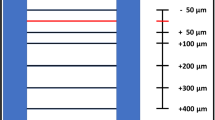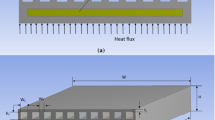Abstract
Micro-electrical–mechanical system (MEMS) has become important for many industries such as automotive, home appliance, portable electronics, especially with the emergence of Internet of Things. Volume testing with temperature compensation has been essential in order to provide MEMS based sensors with repeatability, consistency, reliability, and durability, but low cost. Particularly, in the temperature calibration test, temperature uniformity of thermal cycling based calibration chamber becomes more important for obtaining precision sensors, as each sensor is different before the calibration. When sensor samples are loaded into the chamber, we usually open the door of the chamber, then place fixtures into chamber and mount the samples on the fixtures. These operations may affect temperature uniformity in the chamber. In order to study the influencing factors of sample-loading on the temperature uniformity in the chamber during calibration testing, numerical simulation work was conducted first. Temperature field and flow field were simulated in empty chamber, chamber with open door, chamber with samples, and chamber with fixtures, respectively. By simulation, it was found that opening chamber door, sample size and number of fixture layers all have effects on flow field and temperature field. By experimental validation, it was found that the measured temperature value was consistent with the simulated temperature value.














Similar content being viewed by others
References
Liu S, Liu Y (2011) Modeling and simulation for microelectronic packaging assembly: manufacturing, reliability and testing [M]. Wiley, New York
Pu L, Xiao F, Li Y, Ma Z (2012) Effects of initial mist conditions on simulation accuracy of humidity distribution in an environmental chamber. Build Environ 42:217–222
Antonio CC, Afonso CF (2011) Air temperature fields inside refrigeration cabins: a comparison of results from CFD and ANN modelling. Appl Thermal Eng 31:1244–1251
Chhanwal N, Anishaparvin A, Indrani D, Raghavarao K, Anandharamakrishnan C (2010) Computational fluid dynamics (CFD) modeling of an electrical heating oven for bread-baking process. J Food Eng 100:452–460
Smolka J, Nowak AJ, Rybarz D (2010) Improved 3-D temperature uniformity in a laboratory drying oven based on experimentally validated CFD computations. J Food Eng 97:373–383
Smolka J, Bulinski Z, Nowak AJ (2013) The experimental validation of a CFD model for a heating oven with natural air circulation. Appl Therm Eng 54:387–398
Ding G, Qiao H, Lu Z (2004) Ways to improve thermal uniformity inside a refrigerator. Appl Therm Eng 24:1827–1840
Fukuyo K, Tanaami T, Ashida H (2003) Thermal uniformity and rapid cooling inside refrigerators. Int J Refrig 26:249–255
Mirade PS, Daudin JD, Ducept F, Trystram G, Clement J (2004) Characterization and CFD modelling of air temperature and velocity profiles in an industrial biscuit baking tunnel oven. Food Res Int 37:1031–1039
Mirade PS (2003) Prediction of the air velocity field in modern meat dryers using unsteady computational fluid dynamics (CFD) models. J Food Eng 60:41–48
Khatir Z, Paton J, Thompson H, Kapur N, Toropov V, Lawes M, Kirk D (2012) Computational fluid dynamics (CFD) investigation of air flow and temperature distribution in a small scale bread-baking oven. Appl Energy 89:89–96
Hasanuzzaman M, Saidur R, Masjuki HH (2009) Effects of operating variables on heat transfer and energy consumption of a household refrigerator–freezer during closed door operation. Energy 34:196–198
Geedipalli SS, Rakesh V, Datta AK (2007) Modeling the heating uniformity contributed by a rotating turntable in microwave ovens. J Food Eng 82:359–368
Wang L, Loh A, Gong Z, Chow S (2008) An air-flow based wafer bake system for improved temperature uniformity. J Process Control 18:931–936
Mahamud R, Park C (2011) Reciprocating air flow for Li-ion battery thermal management to improve temperature uniformity. J Power Sources 196:5685–5696
Acknowledgments
The support of Basic Research (973) from Ministry of Science and Technology of PRC with contract number of 2011CB309504 is highly appreciated.
Author information
Authors and Affiliations
Corresponding author
Rights and permissions
About this article
Cite this article
Gui, X., Luo, X., Wang, X. et al. Computational fluid dynamic (CFD) investigation of thermal uniformity in a thermal cycling based calibration chamber for MEMS. Heat Mass Transfer 51, 1705–1715 (2015). https://doi.org/10.1007/s00231-015-1534-2
Received:
Accepted:
Published:
Issue Date:
DOI: https://doi.org/10.1007/s00231-015-1534-2




